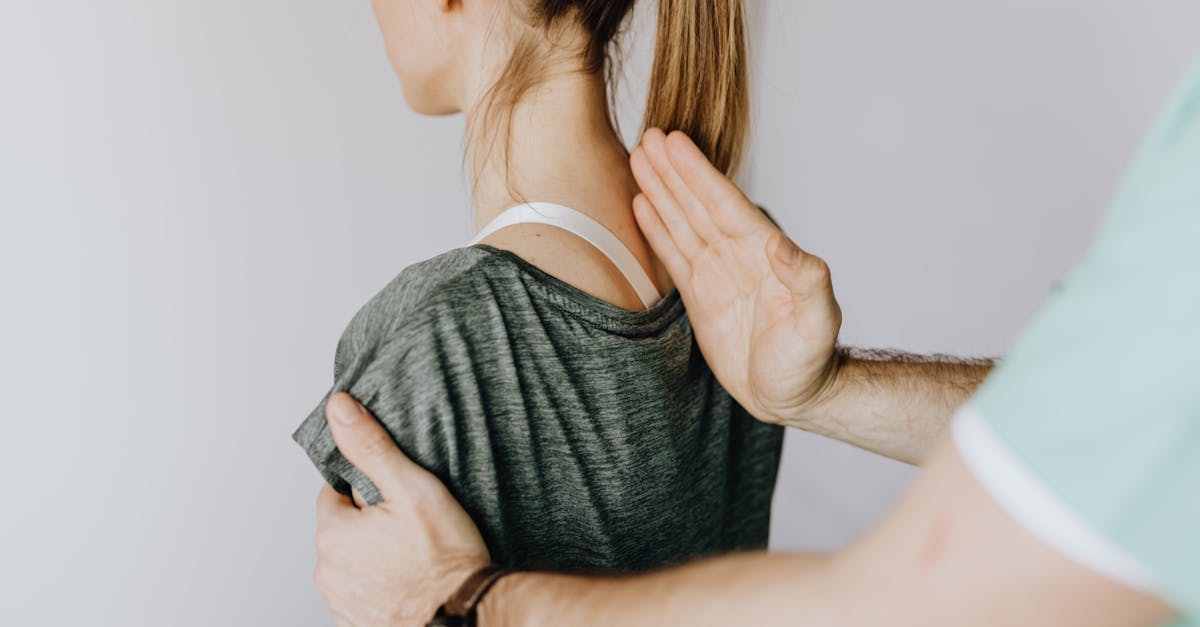Struggling with rounded shoulders and poor posture?
In Short: Rounded shoulders causing you pain and discomfort? Discover how to improve posture with targeted posture correction techniques and innovative approaches. Pulse Align encourages posture exercises and mindful movement, helping you regain natural alignment and confidence. Experience the benefits of core strengthening and restoring proper balance through our unique, simple methods. Reclaim your health and wellness at Pulse Align Clinics. BOOK YOUR APPOINTMENT today!
Are you struggling with lower back pain and poor posture?
Rounded shoulders> can result in significant discomfort, including lower back pain and neck pain, but with Pulse Align’s innovative techniques, you can learn how to encourage realignment and improve posture. Studies show that the majority of adults suffer from bad posture, such as forward head posture and kyphosis. Pulse Align focuses on posture correction, offering targeted posture exercises and methods to promote core strengthening and mindfulness in movement. With a combination of strategies, including yoga for posture and the Alexander Technique, you can achieve optimal alignment and comfort. Discover how embracing these systemic improvements not only addresses rounded shoulders but can also lead to a healthier, more balanced body.
Are you aware of how your body alignment impacts your overall well-being? Posture improvement is not just about standing tall; it’s about creating a harmonious balance within your body. At Pulse Align, we specialize in neuromuscular recalibration, guiding you towards a healthier, more aligned lifestyle. This innovative, gentle approach focuses on establishing proper posture and muscle tone symmetry, allowing you to feel more comfortable in your daily activities.
The Pulse Align Approach to Wellness
At Pulse Align, we understand that realigning your body involves more than simply correcting superficial postural issues. Our unique method promotes muscle tone through gentle stimulation, which encourages natural balance in the body. By restoring symmetry and enhancing overall alignment, you are on your way to a holistic transformation that can lead to less discomfort. This is where our expertise in posture correction truly shines.
Enhancing Well-Being Through Natural Methods
Many clients have embraced the Pulse Align approach, discovering how a focus on natural healing contributes to their overall wellness. Through our services, clients often note improvements in their posture and reductions in tension. Utilizing stretching exercises, core strengthening, and mindful movement, we aim to empower individuals to achieve their best selves naturally. With testimonials that highlight their experiences, clients often share how this gentle method fosters body awareness and facilitates a journey towards optimal functional balance.
Your Invitation to Better Alignment
Ready to explore how you can transform your posture and enhance your well-being? Look no further than Pulse Align. With clinic locations in cities like Montreal, La Prairie, and Terrebonne, we offer convenient access to our services. Family-friendly and welcoming for all ages, Pulse Align is here to support your wellness journey, alongside your healthcare services. Take the first step towards a balanced and aligned life by booking your consultation online today!
- Exercise Techniques: Incorporate specific movements that target shoulder stabilizers.
- Posture Awareness: Cultivate mindfulness about your posture throughout daily activities.
- Gentle Alignment Methods: Utilize holistic approaches to improve shoulder positioning.
- Core Strengthening: Focus on exercises that enhance core stability to support better posture.
- Stretching Routines: Implement stretches that open up the chest and strengthen the back.
- Consultation: Seek professional guidance tailored to your individual posture challenges.
- Consistent Practice: Commit to daily exercises and habits for lasting results.
- Use of Correctors: Consider posture correctors to aid in realignment during daily use.
Introduction: Understanding Rounded Shoulders
Rounded shoulders are a common issue affecting many individuals, often linked to bad posture, prolonged sitting, and lifestyle habits. Identifying and addressing this misalignment not only enhances posture improvement but also promotes overall neuromuscular health. In this article, we will explore how Pulse Align offers effective strategies for posture correction, focusing on practical tips and techniques for realignment.
The Impact of Rounded Shoulders on Your Health
Rounded shoulders can lead to a cascade of additional issues such as forward head posture, neck pain, and tension in the upper back. This compromised alignment can also affect the nervous system, leading to discomfort and restricted mobility. By achieving better symmetry in the body, individuals can benefit from improved motion, reduced discomfort, and a more balanced stance.
Understanding the Causes of Rounded Shoulders
Several factors contribute to the development of rounded shoulders, including poor ergonomics, lack of core strengthening, and insufficient awareness of proper sitting posture. As people tend to lean forward while using technology or sitting at desks, they inadvertently reinforce this misalignment over time, making it essential to understand these origins for effective correction.
Holistic Techniques for Realignment
Pulse Align employs a variety of holistic methods to address rounded shoulders and promote balanced posture. Techniques that include the Alexander Technique and the Feldenkrais Method focus on mindful movement and body awareness, allowing individuals to identify habits that exacerbate their postural weaknesses.
Effective Posture Exercises
Incorporating specific posture exercises into daily routines can significantly improve alignment. Here are a few that target rounded shoulders:
- Chest Stretch: Stand tall, interlace your fingers behind your back, and gently lift your arms to stretch the chest muscles.
- Shoulder Blade Squeeze: Sit or stand up straight and squeeze your shoulder blades together, holding for a few seconds.
- Cobra Pose: Practiced in yoga, this stretch encourages extension of the spine and opens up the chest.
These exercises, along with various stretching exercises and trunk exercises, can be tailored to suit different fitness levels, making them accessible for everyone.
Integrating Daily Practices for Lasting Change
Aside from dedicated exercise, maintaining awareness of body alignment while performing everyday tasks is crucial. Incorporating standing desks and taking regular breaks to stretch or adjust posture can promote long-term change. Additionally, adopting yoga for posture and mindful movement can cultivate a habitual awareness of body positioning.
Taking Action with Pulse Align
To further delve into how these practices can transform your posture, consider booking a consultation with Pulse Align. Their personalized exercise plans and innovative therapies, such as shockwave therapy, can specifically target your unique alignment challenges. Take the first step in reclaiming your health and enhancing your overall well-being.
| Aspect | Pulse Align Approach |
| Posture Awareness | Encourages mindfulness of daily movements to promote natural alignment. |
| Core Strength | Integrates exercises that enhance stability and support for improved posture. |
| Soft Tissue Balance | Utilizes gentle techniques to alleviate tension and encourage muscular balance. |
| Flexibility Enhancement | Incorporates stretching practices that restore mobility in connections and joints. |
| Daily Movement Mechanics | Focuses on adjustments to everyday activities that naturally enhance alignment. |
| Mind-Body Connection | Promotes awareness of body posture and its impact on overall well-being. |
| Educational Resources | Provides guidance on understanding posture through workshops and articles. |
| Holistic Techniques | Applies a comprehensive approach to support body recalibration. |
| Encouragement of Natural Movements | Reinforces primal movements that align and strengthen the body effectively. |
| Community Support | Fosters a supportive environment for shared experiences and encouragement. |
Transformative Wellness Journey: Realigning Posture for a Balanced Life
Clients seeking relief from rounded shoulders have discovered the life-changing approach of Pulse Align. Many individuals report significant improvements in their overall well-being as they engage in this unique program designed to support the body’s natural ability to recalibrate and restore balance. Their testimonials highlight the effectiveness of holistic recovery, emphasizing that minor adjustments in posture can create major shifts in health.
For example, one client from La Prairie shared, “After just a few sessions with Pulse Align, I noticed a remarkable difference in how I carried myself throughout the day. My rounded shoulders felt less constricted, and I could finally breathe deeply without discomfort!” This sentiment resonates with many who benefit from the gentle techniques used by Pulse Align in their pursuit of wellness.
Another client from Saint-Jérôme remarked, “I was skeptical at first, but the combination of targeted exercises and guided awareness truly worked wonders. Not only did my posture improve, but I found myself experiencing less tension and better mobility overall.” This personal journey illustrates the profound impact of Pulse Align’s methods on local residents.
Clients across regions like Mont-Royal and Terrebonne continue to appreciate how Pulse Align collaborates with healthcare teams to support their wellness. A client from Châteauguay noted, “The staff educated me about the importance of posture and provided tools that allowed me to take charge of my health, creating lasting changes that I was able to sustain.” The feedback from these areas showcases how Pulse Align’s innovative techniques resonate with individuals seeking realignment within their everyday life.
Through incorporating practical steps that align with the body’s natural rhythms, Pulse Align empowers clients in places like Chicoutimi and Deux-Montagnes to embrace a healthier lifestyle. As wellness seekers continue their journey, they find that Pulse Align’s commitment to holistic care makes a tangible difference.
To explore personalized solutions that facilitate your journey towards alignment and wellness, consider visiting Our Clinics. Discover how Pulse Align can support you and your family’s health and well-being in your local community.
Relieving Dorsal Pain
By focusing on posture correction and addressing rounded shoulders, Pulse Align provides a path towards a more balanced and pain-free life. The importance of correct posture cannot be overstated when it comes to relieving discomfort and promoting an overall sense of well-being.
The Holistic Approach to Forward Head Posture
Discover how Pulse Align’s innovative techniques can help improve posture, enhance your core strength, and restore your natural alignment. A key aspect of this approach involves recognizing how forward head posture affects our daily lives and making the necessary adjustments to promote better alignment.
Achieving Shoulder Alignment
Engaging in targeted exercises, utilizing posture correctors, and fostering awareness of daily activities significantly improves alignment. Simple strategies can make a notable difference in how your shoulders sit and how your overall posture appears.
Align Your Way
Pulse Align offers a unique approach to achieving optimal posture through its holistic and gentle methods. This innovative technique integrates posture awareness into daily routines, helping individuals cultivate a stronger, healthier posture.
Fixing Rounded Shoulders
This guide will show you how to truly fix your rounded shoulders and achieve a robust posture through natural primal movements and consistent daily exercises. Understanding the root causes is essential to implementing effective changes.
Exercising to Fix Rounded Shoulders Posture
Incorporating specific exercises into your routine can significantly alter the alignment of your shoulders over time, contributing to a healthier and stronger body. Awareness of how our movements impact posture is key.
9 Strategies for Improving Rounded Shoulders and Reducing Discomfort
Rounded shoulders can be remedied with patience, stretching, and a postural reset. Adopting effective strategies allows individuals to reclaim their alignment and enjoy better overall comfort.
Forward Head Posture: Exercises and Stretches
Committing to stretching and strengthening exercises, coupled with a focus on maintaining good posture, can relieve side effects and lead to improved alignment. Recognizing how these simple actions can transform your posture is empowering.
Our Mission
At Pulse Align, our mission is to deliver evidence-based, client-centered treatments that address the underlying causes of pain and dysfunction. By integrating advanced techniques and technologies, we strive to empower each person to take control of their health, ensuring a high standard of care, lasting relief, and an improved quality of life.
Learn more about this approach and available services at www.pulsealign.com and find a location near you here: https://pulsealign.com/our-locations/
Enhance Your Wellbeing with TAGMED’s Spinal Decompression Therapy
TAGMED offers an advanced solution for patients suffering from chronic pain or symptoms associated with conditions such as herniated discs, bulging discs, and moderate to severe spinal stenosis. Designed specifically for these challenges, TAGMED’s Spinal Decompression Therapy is a non-surgical approach aimed at alleviating pain and enhancing mobility. By gently reducing pressure on affected discs and nerves, this evidence-based technique supports your body’s natural healing process. If you’ve reached a plateau with conventional therapies, discover how TAGMED can help you reclaim an active and comfortable lifestyle.
Have you tried conventional treatments and still struggle with persistent back pain due to a severe disc condition?
Mechanism of Action
TAGMED’s neurovertebral decompression applies a controlled, progressive traction force to the spine, effectively increasing the space between vertebrae. This method reduces pressure on intervertebral discs and nerve roots while promoting better fluid circulation in targeted areas. As a result, inflammation diminishes, alleviating pain and offering a reliable, non-invasive solution for individuals dealing with chronic back issues. By restoring proper alignment and functionality of the spine, this therapy can provide effective relief from symptoms related to degenerative disc disease and disc protrusion.
Specific Benefits
The non-invasive nature of TAGMED’s approach effectively alleviates chronic pain linked to conditions such as sciatica or facet syndrome. With its focus on optimizing fluid circulation around the discs and reducing pressure on nerve structures, patients can experience faster recovery and improved quality of life. Through this therapy, the body can naturally heal, allowing individuals to enjoy their daily activities without the burden of constant discomfort.
Comparison with Other Treatments
When considering the options available for managing chronic back pain, TAGMED’s neurovertebral decompression stands out against traditional treatments, including pain medications, corticosteroid injections, and even surgery. Compared to these methods, neurovertebral decompression has distinct advantages: it avoids invasive interventions, minimizes the risks associated with medication, and often leads to quicker recovery. This makes it a compelling choice for those seeking safer, evidence-based alternatives for managing pain.
Case Studies or Testimonials
Numerous patients have seen remarkable improvements in their quality of life after undergoing TAGMED’s neurovertebral decompression therapy. Many testimonials highlight experiences of lasting pain relief, a faster return to daily activities, and reduced reliance on pharmaceuticals. These real-world accounts showcase the effectiveness and practical benefits of this innovative approach, emphasizing the tangible results achievable through TAGMED’s program.
Conclusion: Discover the Path to Realignment with Pulse Align
If you’re struggling with rounded shoulders, it’s time to explore how Pulse Align can encourage natural realignment and bring about a transformative change in your health. By focusing on posture correction, clients have experienced significant improvements in their overall well-being, including enhanced mobility and reduced discomfort.
Many clients have shared their positive experiences with Pulse Align, praising the compassionate and client-centered approach that prioritizes their unique needs. The gentle, non-invasive techniques promote holistic health and work with the body’s own healing abilities, fostering a sense of empowerment and encouragement throughout their wellness journey.
Are you ready to experience the difference for yourself? Don’t wait any longer to embrace a healthier lifestyle. Discover the Pulse Align difference today and take the crucial step towards achieving better posture and an improved quality of life. Book a consultation with us and let us support you on your journey to natural pain relief and overall wellness.
Do you suffer from a chronic condition that responds little or not at all to conservative treatments?
Pulse Align offers a non-invasive, innovative method designed to help restore the body’s natural balance and posture through gentle, imperceptible pulses. This approach encourages the body to reconnect and recalibrate its internal systems, which can lead to reductions in muscle and joint tension. As we explore solutions for those experiencing rounded shoulders and other postural imbalances, discover how Pulse Align’s gentle methods can aid in achieving a more harmonious state of being.
Rather than focusing on discomfort directly, Pulse Align emphasizes the body’s natural capacity to recalibrate itself. By promoting gentle, effective adjustments, clients often report amazing improvements in their overall comfort and posture. This proactive method encourages the body to engage its innate healing mechanisms, leading to a refreshed sense of well-being.
At Pulse Align, we take pride in our personalized approach, creating tailored experiences to meet the unique needs of each client. Many clients share their positive journeys, reporting noticeable improvements in areas like neck and back tension or general well-being. With an inclusive atmosphere, clients of all backgrounds—including families—experience the benefits of a holistic approach to wellness that supports their lifestyle.
We invite you to explore more about Pulse Align by visiting our website, where you can find nearby locations in La Prairie, Mont-Royal, Terrebonne, and other cities. By booking a consultation, you are taking the first step toward experiencing the uplifting benefits of our gentle services. Remember, Pulse Align complements but does not replace any healthcare services you may be receiving.
Pulse Align embraces a safe, non-invasive, and family-friendly philosophy, making it suitable for all ages, including children and pregnant women. Our state-of-the-art technology works in harmony with your body to enhance muscle tone symmetry and promote overall wellness. Each session is customized to ensure that your unique needs are met with care and professionalism.
To learn more about our services and book an appointment, visit our website: Pulse Align.
Frequently Asked Questions
Posture Imbalance, body misalignment
- Are massages helpful for improving body alignment?Massage can relax tense muscles, improve circulation, and facilitate postural adjustments, especially combined with targeted exercises.
- How long does it take to improve misalignment?The timeframe varies depending on severity. With consistent effort, it may take a few weeks to a few months to see significant improvements.
- Can yoga prevent postural imbalance?Yes, yoga improves flexibility, strength, and body awareness, helping prevent and correct imbalance.
- Do relaxation techniques help correct posture?Yes, techniques like meditation or yoga relax muscles, reduce stress, and encourage better body awareness.
- Which exercises help improve body alignment?Core strengthening, planks, yoga, Pilates, and postural stretches are particularly beneficial.
- Do morning stretches help?Yes, gentle morning stretches relax muscles, prepare the body for the day, and help maintain better posture.
- How can I adapt my workstation to improve posture?Adjust chair height, position the screen at eye level, use a footrest, and ensure forearms are parallel to the floor.
- Can mobile apps help improve posture?Yes, some apps offer reminders, exercises, and visual assessments to help correct posture.
- Are regular breaks at work useful?Absolutely, taking breaks to stand, stretch, and move helps reduce tension and improve long-term posture.
- Do endurance sports promote better posture?Some sports like swimming or yoga improve overall muscle tone and support better postural alignment.
Victor Guillot knows that life’s pains can often be traced back to the way we sit, stand, and move. As a Posture Awareness Advocate at Pulse Align, he’s committed to showing readers how small adjustments in alignment can bring big relief. With a blend of empathy and evidence-based research, Victor translates the science of posture into practical steps that help ease discomfort, protect against injury, and restore natural balance. He believes that everyone deserves to feel strong, stable, and pain-free—and through his writing, he offers the guidance and encouragement to help readers reach that goal.
Medical Disclaimer
The information and advice provided on this site do not replace the advice, diagnosis, or treatment of a healthcare professional. Please note that the author of this article is neither a doctor nor a specialist in a medical specialty as defined by the Collège des médecins du Québec. Manual medicine, functional medicine, and sports medicine as described on this site exclude any medical treatment or diagnosis made by a doctor or medical specialist. Always consult your doctor for any medical questions. For more details, please read our complete Legal Notice.
References
- Engebretsen, Lars, et al. “Sports Injuries and Illnesses during the Winter Olympic Games 2010.” British Journal of Sports Medicine, vol. 44, no. 11, 2010, pp. 772–80, https://bjsm.bmj.com/content/44/11/772.short.
- Jayashankar, Venati, and M. Srinivas Naik. “A Research Study on Deaths Due to Injuries to Abdomen Brought to Ananthapuram Govt. Medical College Mortuary, Andhra Pradesh from January 2010 to December 2016.” Medico-Legal Update, vol. 18, no. 2, 2018, pp. 181–84, https://www.indianjournals.com/ijor.aspx?target=ijor:mlu&volume=18&issue=2&article=040.
- Bahr, Roald, and Sverre Mæhlum. Clinical Guide to Sports Injuries. Human Kinetics, 2004, https://books.google.com/books?hl=fr&lr=&id=mmRnr0x0p4QC&oi=fnd&pg=PA86&dq=%22sports+injuries%22+%2B+abdomen&ots=mF6T-o_I4q&sig=CtFsHciVC0aKP7AIcw-wVJdjT6k.
- Guermazi, Ali, et al. “Sports Injuries at the Rio de Janeiro 2016 Summer Olympics: Use of Diagnostic Imaging Services.” Radiology, vol. 287, no. 3, 2018, pp. 922–32, https://doi.org/10.1148/radiol.2018171510.
- Lenjani, Basri, et al. “Emergency Medical Care and Management of Sports Injuries on the Football Court.” Albanian Journal of Trauma and Emergency Surgery, vol. 5, no. 1, 2021, pp. 773–77, http://journal.astes.org.al/AJTES/index.php/AJTES/article/view/172.
- Jarraya, Mohamed, et al. “Sports Injuries at the Rio de Janeiro 2016 Summer Paralympic Games: Use of Diagnostic Imaging Services.” European Radiology, vol. 31, no. 9, 2021, pp. 6768–79, https://doi.org/10.1007/s00330-021-07802-3.
- Kaynaroğlu, Volkan, and Yusuf Alper Kiliç. “Archery-Related Sports Injuries.” Sports Injuries, edited by Mahmut Nedim Doral, Springer Berlin Heidelberg, 2012, pp. 1081–86, https://doi.org/10.1007/978-3-642-15630-4_143.
- Liu, Tao. “Impact of Posture and Recovery Methods on Sports Injuries.” Revista Brasileira de Medicina Do Esporte, vol. 28, no. 6, 2022, pp. 719–22, https://www.scielo.br/j/rbme/a/BRzZwhZBjXSLYCHNH3PpDSL/?lang=en.
- Nielsen, Jesper Möller, and Mats Hammar. “Sports Injuries and Oral Contraceptive Use: Is There a Relationship?” Sports Medicine, vol. 12, no. 3, 1991, pp. 152–60, https://doi.org/10.2165/00007256-199112030-00002.
- Seah, Pei Zhen, et al. “Risk Stratification of Paediatric Sports Injuries Seen at a Tertiary Hospital.” Ann Acad Med Singap, vol. 49, 2020, pp. 955–62, https://www.annals.edu.sg/pdf/49VolNo12Dec2020/V49N12p955.pdf.




